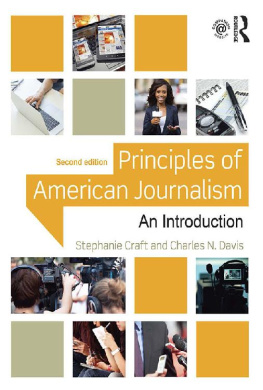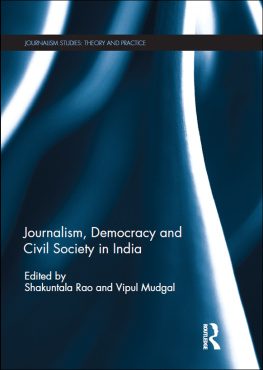Principles of American Journalism
Designed to engage, inspire and challenge students while laying out the fundamentals of the craft, Principles of American Journalism introduces readers to the core values of journalism and its singular role in a democracy. From the First Amendment to Facebook, the new and revised edition of this popular textbook provides a comprehensive exploration of the guiding principles of journalism and what makes it unique:
the profession's ethical and legal foundations;
its historical and modern precepts;
the economic landscape of journalism;
the relationships among journalism and other social institutions;
the key issues and challenges that contemporary journalists face.
Case studies, exercises and an interactive companion website encourage critical thinking about journalism and its role in society, making students more mindful practitioners of journalism and more informed media consumers.
Stephanie Craft is Associate Professor of Journalism at the University of Illinois at Urbana-Champaign. Before earning a doctorate in Communication from Stanford University, she worked as a newspaper journalist in California, Arkansas and Washington.
Charles N. Davis is the Dean of Grady College at the University of Georgia, and is the former executive director for the National Freedom of Information Coalition (NFOIC), headquartered at the Missouri School of Journalism. In 2008, Davis was named the Scripps Howard Foundation National Journalism Teacher of the Year.
Principles of American Journalism
An Introduction
2nd edition
Stephanie Craft
Charles N. Davis
Please visit the companion website at www.routledge.com/cw/craft
This edition published 2016
by Routledge
711 Third Avenue, New York, NY 10017
and by Routledge
2 Park Square, Milton Park, Abingdon, Oxon OX14 4RN
Routledge is an imprint of the Taylor & Francis Group, an informa business
2016 Taylor & Francis
The right of Stephanie Craft and Charles N. Davis to be identified as authors of this work has been asserted by them in accordance with sections 77 and 78 of the Copyright, Designs and Patents Act 1988.
All rights reserved. No part of this book may be reprinted or reproduced or utilized in any form or by any electronic, mechanical, or other means, now known or hereafter invented, including photocopying and recording, or in any information storage or retrieval system, without permission in writing from the publishers.
Trademark notice : Product or corporate names may be trademarks or registered trademarks, and are used only for identification and explanation without intent to infringe.
First edition published 2013 by Routledge
Library of Congress Cataloging-in-Publication Data
Names: Craft, Stephanie. | Davis, Charles N.
Title: Principles of American journalism: an introduction / Stephanie Craft and Charles N. Davis.
Description: 2nd edition. | New York: Routledge, 2016. | Includes bibliographical references and index.
Identifiers: LCCN 2015038721| ISBN 9781138910300 (hardback) | ISBN 9781138910317 (pbk.) | ISBN 9781315693484 (ebook)
Subjects: LCSH: JournalismUnited States. | PressUnited States.
Classification: LCC PN4855.C84 2016 | DDC 071/.3dc23
LC record available at http://lccn.loc.gov/2015038721
ISBN: 978-1-138-91030-0 (hbk)
ISBN: 978-1-138-91031-7 (pbk)
ISBN: 978-1-315-69348-4 (ebk)
Typeset in Warnock Pro, Neutraface and Syntax
by Apex CoVantage, LLC
Editor: Erica Wetter
Editorial Assistant: Simon Jacobs
Production Editor: Sarah Thomas
Copy Editor: Andy Soutter
Proofreader: Deborah Blake
Cover Design: Gareth Toye
Dedicated to Principles of American Journalism students past, present and future.
Contents
This book results from the process of co-teaching the Principles of American Journalism course at the Missouri School of Journalismthe task we were hired for and the course that challenged us and changed our thinking on so many issues, day after day.
In our daily conversations as we took turns teaching the course, we concluded that the many fine Introduction to Mass Media texts on the market did not meet the needs of a course designed to introduce students not to the entire world of mass communication, but to the central role that journalism plays within that broader world. What if we created a text that not only introduced students to journalism as a practice, but also highlighted its values and the many forces promoting and hindering journalisms ability to act in accordance with them? What if, in other words, we could teach students why journalism matters?
We, like so many others, were deeply influenced by The Elements of Journalism, Bill Kovach and Tom Rosenstiels elegant testament to what makes journalism unique and important. It fundamentally changed the way we thought about teaching the course, and underscored the importance of a course that focuses singularly on the news media.
Of course, much has changed and continues to change since we began teaching the course and since Kovach and Rosenstiel published The Elements. We both have moved on to other universities for one thing. But we believe that much of what Kovach and Rosenstiel set forth has stood the test of timeindeed, the ferocity and pace of change make taking a clear stance about journalisms values all the more important. We hope this book does credit to Kovach and Rosenstiels work and pursues, even if it never quite reaches, the goal of making the case for journalisms essential role. In the end, we do feel we have a text that matches the goals of the course.
concludes the book with a spirited discussion of independence, the element of journalism that is central to journalisms ability to fulfill its democratic function.
A book is a collective effort reflecting the labors of many people. Wed be remiss if we failed to recognize the many fine colleagues, former students and friends who have added their expertise to the book through the many sidebar features youll read. They add a depth and breadth to the text, as well as a fresh new voice.
We also would like to thank the thousands of students who marched in and out of Principles of American Journalism in the 13 years we taught it. To say that we could not have done it without you all is trite, maybe, yet so true. Your feedback, your questions in class, your responses to the discussions weve had are all reflected in this book. Likewise, we owe a huge debt of gratitude to the many wonderful graduate students who worked with us at Missouri. Many appear in these pages as contributors to the sidebars, but many, many others played a role in this book through discussions, comments and occasional cajoling. We thank you all.
And finally, we thank our families and friends and colleagues, who have made countless adjustments to their own lives so we could get this book written and now revised. As for the Davis side of the writing partnership: thanks to my dear wife Julie, and my kids, Charlie, and Mamie Davisyour father does nothing without you in mind. And from the Craft side, heartfelt thanks to my husband, Kevin, for his encouragement and good humor.
Navigating the rush-hour traffic on his way to work in January 2009, Sri Lankan newspaper editor Lasantha Wickramatunga was gunned down by two assassins on motorcycles.







